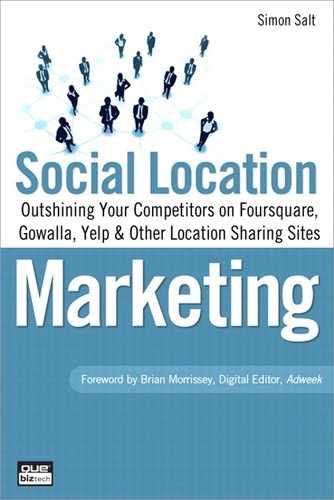8. We’re Here All Week—Event Marketing with Social Location Sharing Apps
Events are a great opportunity for businesses with no physical location or for those that are not accessible to their customers (manufacturing companies that do not have public facing offices, for example) to engage in social location sharing. Whether your organization will have a booth at a major conference or your small business has one person attending a local seminar, each situation presents its own opportunity to use social location sharing apps for marketing.
Companies that are either sponsoring an event or organizing an event have even more to gain from using social location sharing apps as part of their marketing mix.
This is because they get a greater degree of control over how the channel is used for that type of communication. As a sponsor or organizer, a company should expect to have branded elements used as part of any social location marketing campaign for the event.
Event marketing, or at the very least attending events, is the point at which a lot of organizations—especially those in the business-to-business area—meet their customers face-to-face. Although social media has become the “darling” of marketing departments around the world, face-to-face meetings are still where business becomes real. The customer is no longer a voice on the phone, an email address, a Twitter account, or a “fan.” After you meet in person, that customer is now a living human being and it is this point of interaction that can make or break a brand. It is a constant surprise to me that so few brands see the value in this part of their marketing. People buy from people, they don’t buy from brands. Of course there are some caveats. You could argue, for example, that commodities are bought on price not because of the person at the register taking your money for a can of beans. But if you receive bad service from that person, chances are, all other things being equal, you will buy your can of beans from a different store the next time. So even with a commodity, the personal interaction can still affect the buying experience.
Whether it is a large conference in Las Vegas, or a local high-tech happy hour, attending events is the point at which a social media strategy becomes reality and where the cohesiveness of your messaging is put to the acid test. This is one reason why some companies are apprehensive about getting involved in events—the real-world form of marketing. Some companies are concerned that their employees will speak in a way that is “off message.” Cost is another reason some companies don’t participate in events. Purchasing booth space, the cost of the collateral, and the cost of the booth itself can easily run into the tens of thousands of dollars for even a modest booth. Both of these concerns are valid. However, events don’t need to be this source of stress and fear for organizations. There are many ways in which they can achieve excellent engagement with their customers and prospective customers without encountering either off-message communications or huge bills.
Arming Employees with the Right Message
Equipping employees with the right message—one that is both truthful and relevant—and having them attend conferences as attendees (rather than as booth puppets desperately trying to get other attendees to put business cards into a fishbowl) can be a much more rewarding experience for both the employees and the other attendees.
By putting the social media practices developed by the company into operation in the real world and actively engaging other attendees, you are more likely to generate quality leads rather than just a glut of irrelevant business cards. You might even go as far as organizing a small gathering while at the conference.
This is the major issue with conference booths. Unless there is something very compelling about them, conference booths tend to have a very low return on investment. Given that the physical booths cost several thousand dollars to purchase and several hundred just to rent—not including the cost of having the booth graphics and other materials created—a company must seriously consider what type of return they are looking for with this level of investment.
Conference attendees wander past, trying to avoid eye contact. They take the free giveaways, perhaps drop a business card off and leave. The team operating the booth has little or no chance to have any meaningful interactions with the majority of booth visitors and no real opportunity to follow up with them until after the event is over. That follow up tends to come in the form of a generic email sent as part of the overall follow up, most of which will solicit no other response than to have the opt-out option exercised by recipients who have long since forgotten exactly which fishbowls they dropped their cards in anyway.
Ultimately, the business cards simply add to the general clutter of unvetted leads that bloat a CRM system and skew the activity metrics of salespeople. The use of social media—and in particular social location marketing at events—can reduce this clutter. Although it will mean that the number of business cards brought back from an event is greatly reduced, it will also mean that the number of meaningful leads increases, which is much more likely to increase the ROI on attending the event in the first place.
There are caveats—the organization must have a compelling story to tell in the first place. You should also have a product or service that someone actually wants to buy. If you do not, social media will not fix this. In fact, using social media in these situations is only likely to highlight these failings rather than hide them. So for the rest of this section in the chapter, I am going to make the assumption that your organization has already faced these challenges and overcome them appropriately. I am also assuming that you are attending a conference or other event because you have a compelling story to tell about your product or service and that the people who are attending the same conference or event are the people who would be among your prospective buyers.
The principles that I am going to discuss apply equally to large conferences as they do to small events. The key is the interaction with the other attendees, because social location sharing relies on the fact that the person checking in is actually present at the event. This is what makes social location sharing so compelling as a marketing tool at events. You already have some indication of who is present because you have a form of virtual introduction (when the customer checks in). This is not something that you would normally have at an event because most event organizers guard the attendee list closely (and rightly so).
Simply trying to broadcast your message to social location sharers—as we have discussed in other chapters—is not something that is either advisable or welcomed by the users. The messaging has to be subtle and yet also prominent enough to attract attention.
One of the most straightforward ways to leverage social location marketing apps at a conference or event is to use the Mayor feature in Foursquare. Set up your booth as a location in Foursquare, place appropriate signage at the booth inviting people to check in with Foursquare, and award a prize to whoever becomes Mayor. There are limitations to this:
• First, the conference or event has to take place over a period of more than one day.
• There will be only one winner.
• Participants must have to have their Foursquare accounts linked to their Twitter accounts so that you can reach out to them.
This use of Foursquare is certainly a simple and easy option for using social location marketing and less intrusive than a business card in a fishbowl. However, it is not particularly engaging. But if you are new to social location marketing, it’s a good first step, and it’s much better than not attempting anything. I recommend that you at least try this—just to have the experience of setting up a simple campaign and seeing it work.
For a slightly more complex campaign, try using Gowalla or SCVNGR to set up a trip based around the conference or event environment. This kind of campaign can be a much more engaging experience, although it does require some additional work. You will need to select the venues ahead of time and make sure that they are already entered into the spot database or create them. Depending on the type of conference or event you’re attending, you can either set up a trip that occurs inside the venue or make use of locations that are close by.
A trip like this provides attendees with the opportunity to get away from the conference or event location and engage with other businesses in the locality. This might seem counterintuitive to normal conference or event marketing. Why would you want to send the people who you are looking to engage with away from your booth and out onto the streets around the venue?
The point is that the last place on the trip is your booth. Customers go out, learn about the environment they are in, and then they come to find you and your team at your booth. There customers learn that you have something to talk about other than just your product or services. You have created an opportunity for genuine conversation. Although your competitors are still trying to palm off a free pen, you are talking about a great lunch spot or an interesting bookstore that is just around the corner.
This makes your business look a lot more interesting to potential customers because you have differentiated yourself immediately from the other companies at the event, and you are much more memorable. Also, those taking part in your trip will talk about you to each other. Your customers will recommend your trip to other potential customers as a way to get to know the locality (because many conference attendees are visitors).
Creating a trip in Gowalla is a very simple process. You will need a minimum of three locations on your trip before it can be published, but other than that you only need a little imagination for the name.
Create a Gowalla Trip
Creating a Gowalla trip is fairly easy:
- First, create a name for the trip that is both catchy and that includes your company/brand name (see Figure 8.1). You want users to know who is responsible for the trip. Every time people check into one of the locations included in your trip, they will be shown a notification screen telling them that they have completed a check in on your trip. For example, “Get Out & Breathe Bob’s Brew’s Tour” might be a fun name for a trip that gets attendees out of a conference center and into the local area.
Figure 8.1. Create a name that is memorable, and don’t forget to include your company name!
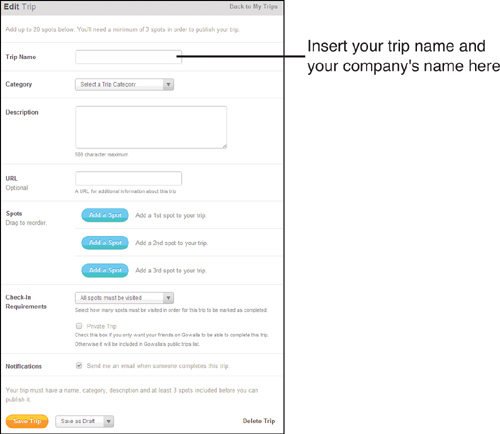
- The next step is to categorize the trip (see Figure 8.2). If you are making the trip focused on one activity, such as restaurants or bars, the choice is fairly obvious. However, for something that ties back to your conference booth, you might want to consider a Photo Walk. The reason is quite straightforward. To use Gowalla or any other social location sharing app, the user will have a smartphone. The other element that all smartphones have in common is a camera. Therefore, putting together a Photo Walk requires nothing more than to pick certain places and then have the participants take pictures of them along the way. The user then uploads them to Gowalla as evidence that they were actually at the location and didn’t just check in from nearby. You could even incorporate the pictures into your booth competition by having them email them to a competition email address and then selecting the best picture.
Figure 8.2. Choose a category for your trip.

- Describe the trip. This is where you to tell people why they should take part. If you are giving something away to the winner or inviting people to attend a gathering, this is where to put it.
- Add a URL. As tempting as it might be, don’t make this your company website. That seems the obvious thing to put in here, but it’s also not very subtle. Instead, why not create a specific landing page just for the trip that is on your domain but is accessible only from this URL? This will give you yet another metric point.
- Add spots to your trip. Adding spots to the tour involves searching for them by name. Type the search term, and a list of possible selections containing that term is displayed. Choose the location you want to use (see Figure 8.3).
Figure 8.3. Add spots to your trip. Keep the number of locations manageable. You don’t want to make the trip too difficult or too long.
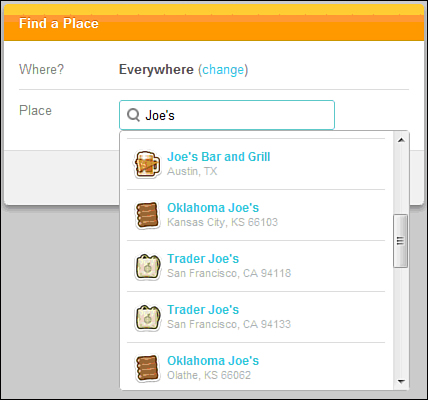
- You then get to determine how a user completes the trip. Do they have to check in at all the spots, or just a few of the spots? Think this through carefully. You want the trip to be fun, you want the trip to be possible to complete, and you have to consider how much time someone will actually want to spend doing this. You also don’t want it to be too easy and therefore lack any sense of challenge or achievement. There is a fine balance between these two elements, and knowing the attendees is key to knowing where this balance lies.
- The final choice is to decide if you want to receive an email notifying you when someone completes the trip. You definitely want that email. It will assist you with your outreach. Check that box and click Publish; you now have a trip that users of Gowalla can use to help them explore the area around the event.
- Make sure that you copy the URL for the trip. It will look something like this: http://gowalla.com/trips/8736 (this happens to be my Austin Coffee House tour). You can then promote the trip before and during the event.
So what does a campaign like this actually look like? What results can you expect from it? The next section shows an example.
Chevrolet at the State Fair of Texas
Let’s look at a nice example from Chevrolet, which partnered with Gowalla to create a series of trips at the State Fair of Texas where they were conducting a brand awareness campaign. The State Fair of Texas is an institution dating back to the end of the nineteenth century and is distinguished by being the largest annual exposition in North America and the largest of the state fairs in the United States.
Like many annual expositions in the USA, it attracts a particular demographic as its primary audience. One of the things to differentiate it from other state fairs is that it is the only one to host an annual motor show and has done so since 1904. This was one of many reasons it became an obvious place for Chevy to run a social location marketing campaign. The majority of the attendees (approx 80%) live within a 50-mile radius of the Dallas-Fort Worth metroplex area, which means that for many, attending the state fair is a family tradition.
Even with the motor show, the majority of people attending the state fair are not going because they want to learn about the latest vehicles from Chevy—they are going to have some fun with their family, go on the rides, see the fairgrounds, win stuffed animals, and eat fried foods. So how would a car manufacturer approach this group of individuals and create trips that they would want to do?
First, Chevy decided to create four trips focused on different elements of the state fair, each with its own unique pin.
• The Chevy Rocks Texas Challenge, which consisted of four spots: the Chevrolet Main Stage, the Chevrolet Town Square and Test Track, the Go Texan Wine Garden Stage, and the Chevrolet Truck Zone.
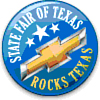
• The Chevy State Fair Classics, which consisted of four spots: Big Tex, Texas Star Ferris Wheel, Cotton Bowl, and Chevrolet Town Square and Test Track.
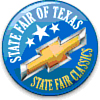
• The Chevy Super-Fan Challenge, which consisted of four spots: Suburban at the Fair Park Coliseum, Chevrolet Town Square and Test Track, Chevrolet Auto Show Booth, and Chevrolet Truck Zone.
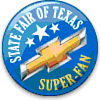
• The Chevy Fried Food Challenge, which consisted of eight spots: Fried Beer, Texas Fried FRITO Pie, Vandalay Concession’s Texas Fried Cookie Dough, Vandalay Concession’s Deep Fried Butter, Yoakum Packaging’s Chicken Fried Bacon, Chevrolet Town Square and Test Track, Fletcher’s Corny Dogs, and The Dock’s Fried Peaches and Cream Stand.
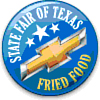
Without too much searching you can probably spot the one place that was common to all the trips—Chevrolet Town Square and Test Track. This was the main base of operation for Chevy at the State Fair and was where visitors could sign up to test drive the latest vehicles, get information about the new vehicles, and generally interact with the Chevy marketing and sales team. By putting that as a spot in all the trips, they were increasing the likelihood that participants would choose to interact at some level with Chevy staff. When a participant completed a trip, she could go to the Chevy team and show them the pin she was awarded and be given a goodie bag of Chevy promotional items.
So what were the results of this campaign? This is a breakdown of the number of people who completed the individual trips and were therefore awarded a pin:
• The Chevy Rocks Texas Challenge—139
• The Chevy State Fair Classics—202
• The Chevy Super-Fan Challenge—132
• The Chevy Fried Food Challenge—128
That is a significant number of people because the demographics of the state fair attendees does not trend toward the smartphone user as a general rule. In addition, this number does not include the participants who were checking in at these locations but who did not complete the entire trip for whatever reason. Those participants were also exposed to the Chevy branded messaging at each spot, so regardless if they then visited the main Chevy area, they were still made aware of the Chevy brand and of Chevy’s presence at the state fair, which was the intent of the campaign. During this campaign, Chevy also received more than 300 new “likes” to their Facebook page, which were directly attributed to this campaign.
These metrics were worked out in advance with their agency to ensure they all knew what elements were going to be monitored as a measure of success and how they would determine if the campaign had actually achieved its goals. Given the environment and that the campaign was run by the corporate communications team rather than an individual dealership, sales was not an appropriate measure to include, and that is perfectly acceptable. There is still a return on investment for this campaign. As I have mentioned before, it is incredibly important to ensure that you are measuring your ROI when putting together a social location marketing campaign.
Interestingly, Chevy opted to do very little in the way of offline promotion for the trips at the state fair. Instead, Chevy relied on users to spread the word. At the main Chevy base, they had one A-board (see Figure 8.4).
Figure 8.4. This was the extent of Chevy’s advertising for the trips at the Texas State Fair.
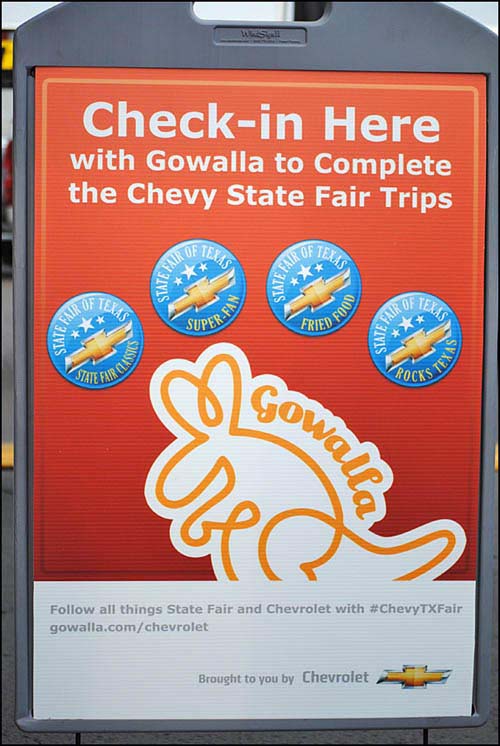
As you can see, the ad gives some basic information but it focuses more on Gowalla than on Chevy. The ad provides a hashtag—ChevyTXFair—for people to use on Twitter and to search for more information about the campaign. The ad also includes a landing page hosted by Gowalla where people can find the full details of each of the trips.
The low-key nature of the ad showed that Chevy recognized the true word-of-mouth nature of social location sharing. They understood that the individuals checking in are in fact the best promotional piece for a campaign rather than a multitude of more traditional marketing communication pieces that will only be lost among all the other pieces given out at events like the state fair.
Not all event promotions have to be focused around a single event or conference to be leveraged as part of a social location marketing campaign. Indeed not all are run by commercial enterprises. Because of the low cost of entry that is presented by social location marketing, nonprofits have turned to it as a method of engaging their prospective audience.
VisitBritain: Social Media Tourism Leader
A good example of an event promotion that is not focused around a single event or conference is VisitBritain, which is the online presence of the British Tourist Authority. VisitBritain was created in April 2003 to market Britain to the rest of the world and to promote and develop the visitor economy of England. It is a department of the British Government and falls under the Department for Culture, Media, and Sport. The website itself has been recognized as a leading example of how tourism and visitor convention bureaus can leverage the Internet to promote their particular areas of interest to tourists. So it is no great surprise that they have ventured into the area of social location marketing to assist with the promotion of visitor attractions in Britain.
VisitBritain decided to partner with Facebook Places to create a ranking table on its own Facebook business page, where it created a new tab called Top 50 Places (see Figure 8.5). The list of these top 50 places is created dynamically by users of Facebook Places and is based on the number of check ins that a particular venue receives.
Figure 8.5. VisitBritain partnered with Facebook Places to create a Top 50 ranking of Facebook Places.
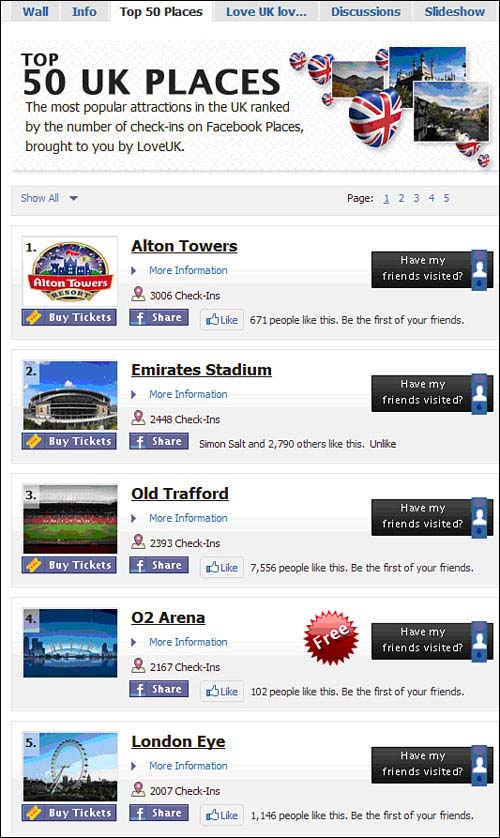
It is interesting that this table counts only those people who have actually checked in at the location, not the number of “fans” or “likes” that a venue receives on Facebook. So, for example, if we look at the top five venues, Old Trafford, the home of Manchester United Football (Soccer) team, has received 2,393 check ins but has also received 7,556 “likes.” This is 6,885 more “likes” than Alton Towers, a theme park, which holds the number one slot with 3,006 check ins.
Why is this significant? Because check ins are an action that results in revenue, whereas “fans” and “likes” do not. There is only a superficial element of loyalty in a Facebook user clicking the “like” button on a particular Facebook page. However, when a person goes to the actual venue and checks in, there is a much greater likelihood that the person has gone there not just to check-in but to attend the venue as a visitor. Not all the venues that make the list charge an entrance fee. For example, the O2 arena is free to visit, although events that are held there usually charge for attendance. However, even those venues that charge no admission or that are just landmarks, such as Trafalgar Square (number six on the list), generate revenue for the surrounding area.
By creating this list, VisitBritain has not only utilized social location marketing, they have done so in a way that uses the data being provided by their own existing audience to assist in the promotion of venues to their potential audience. The bottom line is that they are using past visitors as promoters to future visitors. The list of 50 top places becomes not only a marketing tool but adds value to the experience for those viewing the VisitBritain Facebook page, which again assists in generating loyalty to the overall brand as a source of information.
If you were planning a visit to Britain, what better way to discover the places that you might want to add to your list than to see those places that get the most visitors. At the very least, the places on this list are implied as being the most popular destinations. Of course, you could also use the list to make sure you avoided those spots that attract the most tourists if you wanted to seek out the venues that are off the beaten path. Either way, this list becomes a valuable resource, especially as over time the venues on it will change. The venues listed, as well as the popularity of each, will change as more users check in and as the seasons change and indoor venues increase in popularity over outdoor venues. Some will swell in their check-in prominence around certain events. For example, Trafalgar Square attracts millions of visitors for the New Year’s Eve celebrations held in London, as does Edinburgh Castle. So these types of events will skew the popularity of certain locations at certain times of the year. However, even with these anomalies taken into consideration, VisitBritain has used social location sharing data to create a valuable asset for both their own campaigns and for their target audience.
State of Arkansas Gets Location Aware
VisitBritain is not the only tourism body to see the potential that social location marketing offers their particular areas of marketing. The State of Arkansas became the first state to partner with a location app provider in September 2010 when they selected Gowalla. The State Tourism board had looked at several of the app providers and decided that the Gowalla model of trips was best suited to the type of communication that they wanted to achieve with their visitors.
In a campaign that was similar in its scope to the Chevy State Fair of Texas campaign, the state of Arkansas created five trips for visitors to the state to use as part of their discovery of the different aspects that the state has to offer.
• Haunted Arkansas—This trip has 10 spots that form the trip:
The Crescent Hotel
Basin Park Hotel
Fort Smith National Historic Site
King Opera House
Mount Holly Cemetery
The Empress of Little Rock
Rush-Gates House
Peppersauce Bottom
Gurdon Light
The Allen House
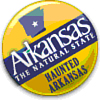
• Historic Arkansas—Another 10-spot trip, consisting of the following:
Fort Smith National Historic Site

Waltons 5-10
Arkansas Post National Memorial
Bill Clinton Birthplace Home
Toltec Mounds Archeological State Park
Louisiana Purchase Historic State Park
Little Rock Central High School
Potts Inn Museum
Historic Arkansas Museum
Arkansas Museum of Natural Resources
• Arkansas Float Trip—A trip comprising six spots:
White River
Spring River
Little Red River
Buffalo River
Caddo River
Ouachita River
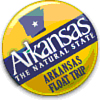
• Billgrimage—A seven-spot trip made up of the following:
Bill Clinton Birthplace Home
Hot Springs High School
Clinton House Museum
Arkansas State Capitol
Old State House Museum
Clinton Presidential Library and Museum
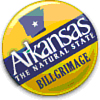
• Arkansas Traveler—A 15-spot trip comprising the following:
Clinton Presidential Library and Museum
Big Dam Bridge
Fort Smith National Historic Site
The Lodge at Mount Magazine
Dickson Street
Basin Spring Park
Blanchard Springs Caverns
Hemingway-Pfeiffer Museum
Arkansas Wine Country
Bathhouse Row
Crater of Diamonds State Park
Arkansas Museum Of Natural Resources
Delta Cultural Center
Arts and Science Center
Arkansas Welcome Center Lake Village
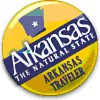
What is very different from other organizations that have created this type of campaign is that each of the trips stands alone. There is no common spot to them and no obvious intent to drive traffic to a particular destination. Also, the tourist board opted to not require users to visit all the locations to complete the trip. Four of the trips require a user to check in at only three of the locations to receive the pin, and just one trip—the Arkansas Traveler trip—requires the user to check in at five of the locations.
Choosing to not make people check in at all of the locations follows the advice I mentioned earlier in the chapter—make the trips fun and achievable. If users had to check in at all 10 venues on the Historic Arkansas trip to get their pin, they might well give up before starting. Because the trip might be part of a family vacation, not all the family might want to spend their entire vacation in historic locations.
The trips serve more as a value add to the visitors than an obvious marketing ploy. However, by positioning its campaign in this way, similar to the way VisitBritain positioned its campaign, the Arkansas Tourist board is positioned as the de facto destination for information on how to get the most out of visiting the state.
Keep in mind that a campaign of this size is created for the long term and not for a shorter engagement. This kind of campaign must become a part of the broader marketing communication efforts that the board undertakes. Unlike the Chevy campaign, which had only a five-week window in which to operate, these trips are available year-round. At the time this book was written, only one of the trips had been completed by a user, although all the trips had spots that had some check ins. (The campaign had been active for a little less than three months when this book was written).
The metrics for this type of campaign would be very different from the Chevy campaign. If the same measures were applied, this campaign would already be considered a failure. Instead, and with the longer term vision in mind, appropriate metrics would be the increase in visitors to each of the venues that correspond with the check ins that take place. In addition, follow-up communication with the users who check in might yield recommendations and feedback on how to improve those venues.
Intel Inside
Consumer marketing organizations and tourism are not the only types of companies to leverage social location marketing. Intel partnered with Foursquare to reach the audience at the 2010 Consumer Electronics Show (CES), in Las Vegas. Despite the name of the event, CES is in fact a trade-only show and not open to consumers. Rather, it is an opportunity for Original Equipment Manufacturers (OEMs) to display their latest products to their customers—the retailers who will be selling them.
Business-to-business has long been the red-headed stepchild of social media marketing. It is hard for this particular sector to leverage the viral, word-of-mouth glitz that consumer-focused campaigns attract. However, Intel managed to appeal to its target audience at CES by creating a competition that required visitors to CES to follow Intel on Foursquare (www.foursquare.com/user/intel) and then check in at various locations in Las Vegas during the convention to unlock various Intel inspired “To-do’s.” The partnership with Foursquare also included three special-event badges, known as Intel Insider badges (a play on the company’s famous tag line—Intel Inside). These badges were awarded to users who checked in at specific events during CES.
• Intel Badge—Awarded for checking in at the Intel Insider Core Kick-Off event held at Sushi Samba in Las Vegas.
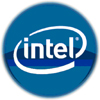
• Work That Core Badge—Awarded for checking in at the Intel CES booth during the conference.
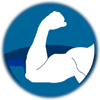
• All Ears Badge—Awarded to users who checked in at the Paul Otellini’s Intel CES keynote.
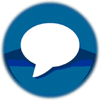
For each badge that users unlocked, they were entered into a prize drawing to win an Intel-powered netbook. So there was an incentive to unlock all three badges and therefore be entered three times into the prize drawing. Over the course of four days, Intel had more than 500 entries into the competition. The audience at CES tends toward the tech savvy early adopter, which is a perfect fit for social location marketing. This is a good example of a company knowing its audience and understanding what would motivate them to take part in a campaign of this nature. With more than 100 entries per day, Intel definitely did a good job of putting together a compelling campaign and getting a very good level of participation.
Intel isn’t the only business-to-business organization to leverage its presence at a conference as an opportunity to use social location marketing to communicate with potential customers.
Lotus Gets Social on a Boat
At the Enterprise 2.0 conference in Boston, IBM’s Lotus division decided to host a party on a boat during the conference. While on the boat, attendees were given the opportunity to see demonstrations of the Lotus Social Computing, Collaboration, Mobile, and Web Portal offerings. Lotus subject matter experts were also on hand to answer questions about the products and provide a more personal experience for the guests.
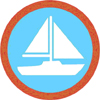
When IBM decided to utilize social location marketing, the Lotus team saw an obvious opportunity to partner with Foursquare, which already had a badge that was very relevant—the “I’m on a boat” badge. This badge is usually awarded to users checking in at a venue that has the tag “boat”; not all these venues are in fact boats. Some are restaurants at marinas or boat docks; others are simply boat-themed venues such as the Pirates of the Caribbean ride at Disney World.
So why not use this existing badge for an event that was taking place on an actual boat? This is where a little creativity and some user knowledge go a long way. Had the Lotus team not already been aware of this badge, they might well have missed this opportunity to use something that preexisted as a tie-in to their event. This reinforces my mantra that before you start using these apps as marketing tools, you first get to know your users.
Given that Lotus had limited space available on the boat (a maximum of 300 people could attend) they needed a way to limit the party. First, guests had to be fullticket attendees at the conference. Second, guests had to check in at the Lotus booth at the conference for ticket giveaways. This is a great example of using social location marketing to drive booth traffic while providing an incentive to the user to take part.
So Lotus drove traffic to its booth and they were able to drive guests to attend their offsite party on the boat and ensure that these were highly engaged individuals with whom they could have meaningful discussions about their products. This level of interaction is not always achievable at a conference booth.
This campaign shows that social location marketing efforts can be very targeted with extremely narrow goals and yet still contain the elements necessary to drive engagement—fun, achievability, and measurability.
Gowalla Calendar
Gowalla offers another method of promoting an event at a location: the Gowalla calendar. Currently available only for Austin, New York, and San Francisco, Gowalla is selling dates for 2011 that will receive a custom stamp designed specifically for the location or the event.
Purchasing a date gets the organization three major pieces of marketing collateral:
• An original Gowalla passport stamp—This appears in the user’s passport as well as on Facebook when a user’s Facebook account is connected to a Gowalla account or checks in via Facebook Places (see Figure 8.6).
Figure 8.6. An original Gowalla passport stamp.
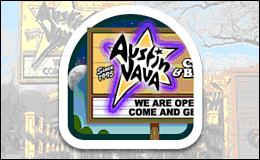
• Featured Event or Venue status—This appears on the date of the event, which puts the event or location at the top of a user’s list of nearby venues when using Gowalla.
Figure 8.7. Featured Event or Venue status means your event appears at the top of the user’s nearby venues.
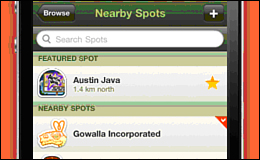
• A set of two 5×7 window clings—These clings feature the custom designed passport stamp for the venue to display and promote the event in advance of the date purchased.
Figure 8.8. Use the custom-designed window cling to promote your event.
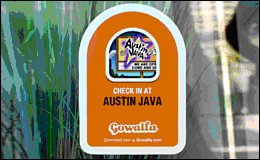
By late 2010, January 2011 had already sold out (see Figure 8.9). The cost varies for each date, and interestingly, the pricing model that Gowalla has adopted means that the further into the future your selected date is, the more expensive it is.
Figure 8.9. Booking too far in advance will cost you more money.
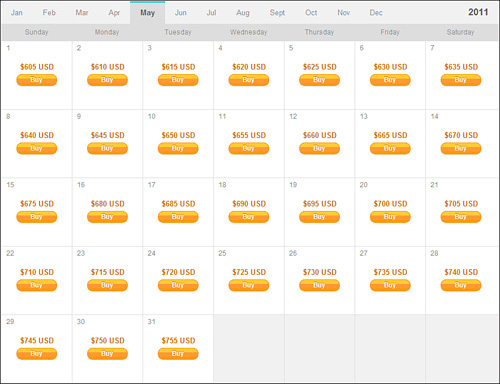
The example shown in Figure 8.9 shows the increasing price of dates in May 2011 for Austin. It can be seen that the cost rises by $5 per day as you progress toward the end of the month, and this price rise continues throughout each month until December 31, 2011.
This is an interesting move by Gowalla; I would guess it is designed to see how much interest there is by marketers in purchasing specific dates. I would certainly expect to see the pricing model change for 2012 so that specific dates in the calendar become more valuable than others. For example, Super Bowl Sunday is likely to be more desirable than an ordinary Sunday for a bar in a particular city if they are holding a Super Bowl watch party.
App developers, such as Gowalla, who are rolling out easier and lower-cost methods for marketers to enter the social location marketing arena, will only encourage more adoption by businesses. One of the criticisms of social location marketing by the media at present is that the use of it by business outstrips the demand for it by consumers. They cite the fact that only 4% of online adults use social location sharing apps. In 2008, the same number was true for users of Twitter, but two years later that number had quadrupled. Many marketers have learned their lesson from missing the early ride that Twitter provided. They are coming to grips with the concept of social location marketing now, before the consumer becomes more adept at it than they are. They are testing what types of campaigns work and what appeals to their particular audiences more.
By doing this now, before the apps have their big shakeout, marketers who are already engaged have a competitive edge over those who have yet to try this form of communication. By the time the platforms consolidate and the offerings are streamlined, it will become increasingly harder for marketers to make an impact with this type of communication—just as it has become with Twitter.
Facebook Deals
In 2010, Facebook announced Facebook Deals as part of the Facebook Places app—a merchant program that is currently being rolled out to a limited number of participating merchants. The program allows merchants to add offers to their locations that are redeemable by Facebook Places users when they check in at the location. The offer might be something as simple as 50% off the price of a cup of coffee or a more complex offering that is part of a bigger reward.
There is nothing particularly special about the Deals program; in fact, it mirrors the early deals programs that were offered via Foursquare and Gowalla. The concept is very similar in nature to the Foursquare Mayor offers that first started the idea of social location marketing a couple of years ago.
Facebook provides an example of a deal which is 50% off a cup of coffee—plugging into the expectations already set by other social location sharing apps.
However, Facebook Deals has immense potential because Facebook has an audience of 500 million compared to Foursquare’s 4 million, and Gowalla’s almost 1 million. Facebook Places Deals is very likely to bring to the attention of the mainstream online community that there are bargains to be had for simply sharing their location and helping to promote their favorite locations.
This, in turn, will increase the pressure on brands, companies, and organizations to offer incentives for users of these apps at their locations, events, and conferences. The social consumer is having the expectation built for them by the creators of the social location sharing apps that they will be rewarded for sharing their location and promoting a business. The social consumer is no longer satisfied to tout your business, event, product, or service for you by carrying around your logo unrewarded.
Summary
When using social location marketing at an event or conference, think about how the campaign will add value to the audience experience at the event or conference. Will they learn more about the conference? Will they find out useful information about the area around the event location? Will they win a valuable prize?
Your decision about what type of value you are going to add to the audience experience will then help you decide which of the apps you are going to use to run the campaign. As we have already seen, each of the apps has different capabilities and lends themselves to different types of campaigns.
Set clear metrics about how the campaign will provide additional value to the company above and beyond what has been seen before when attending a conference or event. What have you brought back in the past? What will you bring back with the use of this campaign that is different, and how will that benefit the greater organization? This has to be something of greater significance than simply increasing the number of “likes” on the company Facebook page. Focusing on the capability to provide higher quality leads to the sales force is a much better way of ensuring internal buy-in.
Remember that as a marketer you are selling the idea internally as much as you are trying to sell it to your prospective customers.
